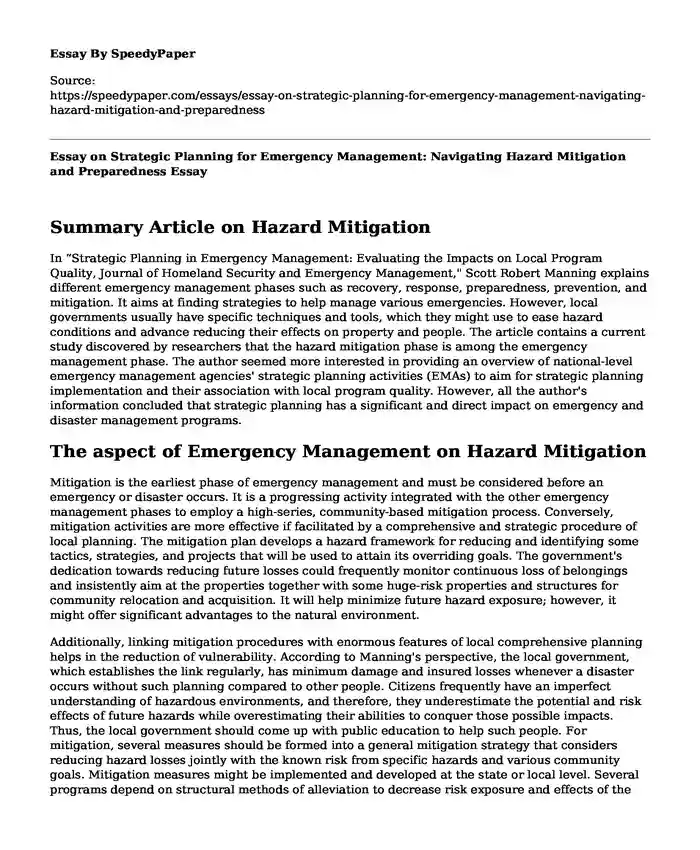
| Type of paper: | Essay |
| Categories: | Planning Management |
| Pages: | 3 |
| Wordcount: | 554 words |
Summary Article on Hazard Mitigation
In “Strategic Planning in Emergency Management: Evaluating the Impacts on Local Program Quality, Journal of Homeland Security and Emergency Management," Scott Robert Manning explains different emergency management phases such as recovery, response, preparedness, prevention, and mitigation. It aims at finding strategies to help manage various emergencies. However, local governments usually have specific techniques and tools, which they might use to ease hazard conditions and advance reducing their effects on property and people. The article contains a current study discovered by researchers that the hazard mitigation phase is among the emergency management phase. The author seemed more interested in providing an overview of national-level emergency management agencies' strategic planning activities (EMAs) to aim for strategic planning implementation and their association with local program quality. However, all the author's information concluded that strategic planning has a significant and direct impact on emergency and disaster management programs.
The aspect of Emergency Management on Hazard Mitigation
Mitigation is the earliest phase of emergency management and must be considered before an emergency or disaster occurs. It is a progressing activity integrated with the other emergency management phases to employ a high-series, community-based mitigation process. Conversely, mitigation activities are more effective if facilitated by a comprehensive and strategic procedure of local planning. The mitigation plan develops a hazard framework for reducing and identifying some tactics, strategies, and projects that will be used to attain its overriding goals. The government's dedication towards reducing future losses could frequently monitor continuous loss of belongings and insistently aim at the properties together with some huge-risk properties and structures for community relocation and acquisition. It will help minimize future hazard exposure; however, it might offer significant advantages to the natural environment.
Additionally, linking mitigation procedures with enormous features of local comprehensive planning helps in the reduction of vulnerability. According to Manning's perspective, the local government, which establishes the link regularly, has minimum damage and insured losses whenever a disaster occurs without such planning compared to other people. Citizens frequently have an imperfect understanding of hazardous environments, and therefore, they underestimate the potential and risk effects of future hazards while overestimating their abilities to conquer those possible impacts. Thus, the local government should come up with public education to help such people. For mitigation, several measures should be formed into a general mitigation strategy that considers reducing hazard losses jointly with the known risk from specific hazards and various community goals. Mitigation measures might be implemented and developed at the state or local level. Several programs depend on structural methods of alleviation to decrease risk exposure and effects of the tragedy; however, efficient programs depend equally on non-structural methods of mitigation.
Conclusion
In conclusion, mitigation activities must be recognized earlier before an emergency occurs to reduce the hazard and damaging effects of fire. The local government should set up different programs that will educate people on taking precautions and methods of handling an emergency. The local government needs to take firm action to eliminate or reduce the long-term dangers to property and individuals from hazards and their impacts. Generally, mitigation is the initial emergency management phase; therefore, the government must deal with early management before a disaster occurs.
References
Manning, S. (2020). Strategic Planning in Emergency Management: Evaluating the Impacts on Local Program Quality, Journal of Homeland Security and Emergency Management, 17(3), 20190051.
Cite this page
Essay on Strategic Planning for Emergency Management: Navigating Hazard Mitigation and Preparedness. (2024, Jan 02). Retrieved from https://speedypaper.com/essays/essay-on-strategic-planning-for-emergency-management-navigating-hazard-mitigation-and-preparedness
Request Removal
If you are the original author of this essay and no longer wish to have it published on the SpeedyPaper website, please click below to request its removal:
- Free Essay with Advertisement Analysis: Transport Accident Commission
- Starbucks Corporation's WACC, Essay Sample for Students
- A Brief History of the Company. Free Essay Example
- Essay Example: New District Manager
- Policy Scenario - Free Paper Example
- Types of Conflict - Free Paper Sample
- My Football Coach Profile - Paper Example
Popular categories




